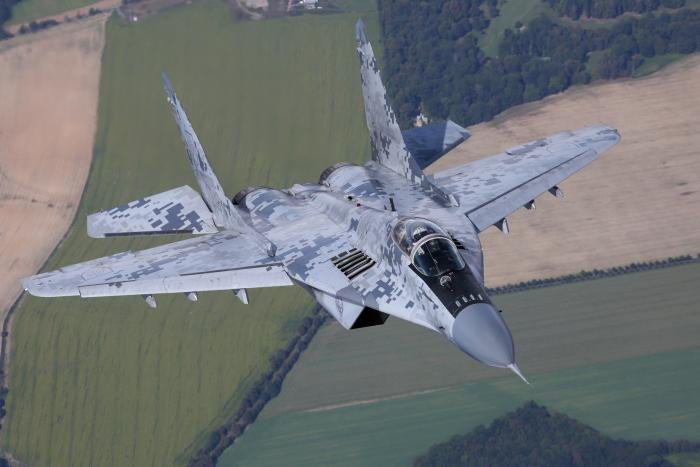Having recently bid farewell to its iconic fleet of Mikoyan-Gurevich MiG-29AS/UBS Fulcrum fighters after more than 30 years of operational service, Slovakia is now discussing how best to use the 11 decommissioned aircraft with its allies and a move to transfer them to Ukraine is definitely on the table.
Veterans of the former Czechoslovak Air Force before the Warsaw Pact nation was split to form two new states – the Czech Republic and Slovakia – in 1993, the Fulcrum served as the backbone of the Slovak Air Force’s combat air forces until its 11 remaining aircraft were grounded for the final time on August 28.
The outgoing MiG-29 fleet marked its retirement from Slovak service by conducting a final four-ship formation flight during the Slovak International Air Fest, which was held at Malacky-Kuchyňa Air Base from August 27-28. This formation flight comprised four single-seat MiG-29AS Fulcrums (serials 0921; 2123; 6124 and 6627). A traditional water cannon salute was organised for MiG-29AS (serial 0921) after landing to mark the end of Fulcrum operations in Slovakia. A fifth MiG-29AS (serial 6425) was also present in the static display.

Commenting on the type’s withdrawal from service, Slovak Defence Minister Jaroslav Nad’ said: “The MiG-29s have a long, good record of service in the Slovak Air Force to the benefit of protecting Slovak airspace. Our pilots have logged over 20,240 flying hours on the aircraft, both on exercises and operations. However, for Slovakia, there are no prospects for the operation of Soviet-era equipment into the future.”
He went on to explain that continuing to operate the Fulcrum fleet under the current circumstances would be very demanding from a logistics, economic and personnel perspective. “With their operability and warfighting capability degraded by low reliability, these air assets are incompatible with our NATO allies and can no longer be upgraded,” he added.
At the time of its retirement, Slovakia had 11 modernised Fulcrums at its disposal, comprising nine single-seat MiG-29AS fighters (serials 0619; 0921; 2123; 3709; 3911; 6124; 6425; 6627 and 6728) and a pair of two-seat MiG-29UBS fighter-trainers (serials 1303 and 5304). These aircraft – operated by the 1st Tactical Squadron from Sliač Air Base in central Slovakia – were upgraded between 2004-2006, during which they received NATO-compatible communication and navigation systems. Three non-modernised Fulcrums – comprising two single-seat MiG-29As (serials 0820 and 5113) and a sole two-seat MiG-29UB (serial 4401) are also kept in long-term storage at Sliač.
While these Soviet-era fighters are now incompatible and growingly obsolete within the NATO structure, the Slovak Ministry of Defence (MOD) claims that its remaining 11 aircraft can reach the end of their projected service life of between 2029-2035. In announcing the retirement of its MiG-29s, the Slovak MOD revealed it was discussing the future of the aircraft with its allies, but no prospective future end-users were disclosed. With this in mind, there is one such European MiG-29 operator that would make very good use of Slovakia’s redundant fighters: Ukraine.

Elaborating on this, Maj Martina Koval’ Kakaščíková – spokesperson for the Slovak MOD – told Key.Aero: “We have been in talks with our allies on what to do next with the grounded MiG-29 fighter jets. The MOD will thoroughly analyse all options and make sure the outcome is advantageous and safe for the Slovak Republic and, if a deal is made, helpful to Ukraine. No decision has been made on this issue yet. We will provide more information as soon as an update is available.”
Since Russia invaded Ukraine on February 24, calls for allied nations to donate their fleets of ageing Soviet-era fighters to the war-torn country have been a relative constant. While aircraft have been donated to Ukrainian Armed Forces to support the defence of its sovereign territory – such as former Afghan Air Force Mil Mi-17V-5 Hip-Hs (donated by the US); Czech Mi-24/35 Hind attack helicopters; Latvian Mi-2MSB Hoplites and Mi-8MTV-1 (Mi-17) Hips; and North Macedonian Sukhoi Su-25 Frogfoot-A/B ground attack jets – no air-to-air combat-capable fighters have been delivered to Ukraine thus far. However, that could change if a deal is struck for the second-hand Fulcrums from Slovakia.
The Slovak MiG-29 fleet will be replaced by 14 Lockheed Martin F-16V Block 70/72 Fighting Falcons, which were formally ordered in December 2018 after the US State Department approved the proposed Foreign Military Sale (FMS) on April 4, 2018. A production contract – worth $799m – for the new-build fighters was awarded to Lockheed Martin on July 31, 2019, with work expected to be completed by January 31, 2024.
However, the Slovak Air Force has yet to receive the F-16V and first deliveries are not expected to take place until 2023, despite rumours that this has been delayed to 2024. With the retirement of its only tactical fighter – the MiG-29 – this has created a significant capability gap for Slovakia, which means the nation has to rely on its allies to defend its domestic airspace until the F-16V comes online. To accommodate this, Saab JAS-39C/D Gripens from the Czech Air Force and F-16C/D Block 52+ Fighting Falcons of the Polish Air Force will be tasked with patrolling Slovak airspace from September 1, 2022, to December 31, 2023 – when Slovakia should regain its temporarily lost fighter capability with the introduction of the F-16V.

